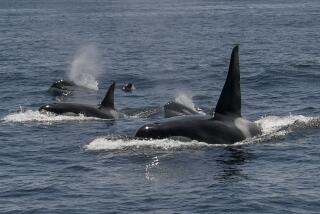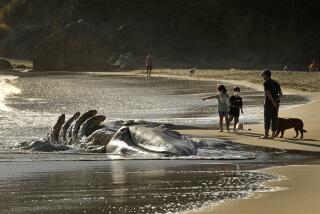Scientists solve a whale of a mystery: Why orcas have menopause
- Share via
Sifting through more than four decades of data on two killer whale populations in the northwest Pacific, an international team of scientists says they’ve discovered why killer whales go through menopause: their complicated relationships with their daughters.
The findings, described in the journal Current Biology, shed light on the conflict and cooperation that have pushed these mammals to give up fertility so early in their lifespans.
Out of all the mammal species in the world, only three are known to experience menopause: humans, short-finned pilot whales and killer whales. But the exact reasons for it in killer whales (known formally as Orcinus orca) have remained up for debate.
“Why females of some species cease ovulation prior to the end of their natural lifespan is a long-standing evolutionary puzzle,” the study authors wrote. “The fitness benefits of post-reproductive helping could in principle select for menopause, but the magnitude of these benefits appears insufficient to explain the timing of menopause.”
Certainly, long beyond their most fertile years, older females play crucial roles in the lives of many social mammals. Researchers have argued that the presence of grandmothers in human populations helped improve the survival rates of their daughters’ offspring. In a herd of elephants, typically run by a long-lived matriarch, older females help out with grandchildren and other relatives. Grandmothers help improve survival in these groups because they often find and share food resources communally. That’s also true of killer whales, the researchers pointed out.
“Resident killer whales forage in social groups and feed almost exclusively on salmon during the summer months, and individual salmon are often shared with other group members,” the scientists wrote.
But elephants don’t go through menopause; females can birth calves well into their golden years. So why do orcas give up on fertility? After all, female killer whales can live into their 90s but stop reproducing in their 30s and 40s — which, for long-lived individuals, means they might be fertile for less than half of their lifespans.
To find out, a British-led team of scientists analyzed 43 years’ worth of data on two populations of killer whales living in the northwest Pacific off the U.S. and Canadian coastline. The data had been collected by the Center for Whale Research in Washington state and Fisheries and Oceans Canada in British Columbia.
As it turned out, older mothers who had calves around the same time as their daughters had a far greater risk of losing their offspring before age 15 (which is around the time when males and females reach sexual maturity). The older mothers’ offspring were 1.67 times as likely to die as their daughters’ offspring were.
The scientists think that this dynamic may arise because of the structure of orca pods. Killer whales, male and female, tend to stay with their maternal pod; males actually go visit other pods to mate and then return to their own. So as a female orca ages, she ends up being more related to members of the group than her daughters are. The study authors explain:
“At the start of her reproductive life, a female’s relatedness to males in her local group is relatively low, because her father is from a different social group,” they wrote. “As a female reproduces, her sons will remain in her group, increasing her overall age-specific local relatedness.”
So an older female orca might be motivated to ensure the survival of many members of her family, not just her own. Her daughter, however, is not as related to the group overall – and so competing with them to feed her own offspring makes more evolutionary sense.
In short, the benefits of grandmothering may have played some role in the success of older female killer whales – but the costs of being outcompeted by their daughters may have played a key role in the emergence of menopause. Scientists say they’ll have to take both aspects of that complex relationship into account to understand the behavior and life cycle of these remarkable animals.
“Models incorporating both the inclusive fitness costs of reproductive conflict and the inclusive fitness benefits of late-life helping (grandmother and mother benefits) may explain why, of all long-lived social mammals, prolonged post-reproductive life appears to have evolved only in humans and toothed whales,” the study authors wrote.
That’s especially important given that the Southern Resident killer whales, known as “cultural icons” of the Salish Sea and one of the populations studied in this paper, are listed as endangered and at risk of extinction.
Follow @aminawrite on Twitter for more science news and “like” Los Angeles Times Science & Health on Facebook.
MORE IN SCIENCE
Vowel sounds made by baboons show that the roots of human speech may go back 25 million years
Experts have only a hazy idea of marijuana’s myriad health effects, and federal laws are to blame
PG-13 movies showcase the most – and the most unrealistic – gun violence, study shows







